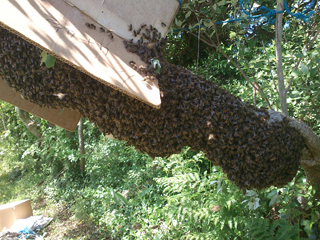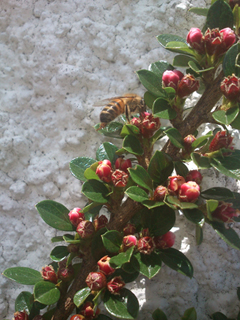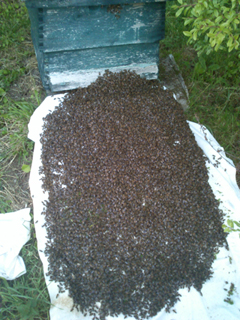 This year has seen a slow start for the bees, despite the weather appearing to be so favourable. I think it mainly is down to the fact that the bees brought in so much ivy honey in the autumn that there has been little room available for the queen to lay, as it takes quite a long time for the bees to dilute the granulated honey for use.
This year has seen a slow start for the bees, despite the weather appearing to be so favourable. I think it mainly is down to the fact that the bees brought in so much ivy honey in the autumn that there has been little room available for the queen to lay, as it takes quite a long time for the bees to dilute the granulated honey for use.
Early on also, the weather was unpleasantly cold, so it was not possible or desirable to open up the colonies to examine for this fact. Colonies have therefore generally developed only slowly, apart from the odd one or two which have decided to do their own thing and build up so fast that they want to swarm, but don’t ask me how these colonies can do it when others can’t!
The weather during April and most of May has, however, resulted in the bees starting to get the hang of what they are supposed to do and having cleared the ivy honey for the queen to have space to lay can now get on with bringing in fresh pollen and nectar to replenish the old stores. In fact, outside our kitchen window we have a wall-trained cotoneaster which has been alive with bees for the past four to five weeks – a lovely sight to see and sound to hear.
 The viburnum was the mainstay of the bees forage earlier on but that is now finished. However, it does show how important these plants are for the early bees to satisfy their need for abundant nectar and pollen supplies.
The viburnum was the mainstay of the bees forage earlier on but that is now finished. However, it does show how important these plants are for the early bees to satisfy their need for abundant nectar and pollen supplies.
It is not just nectar and pollen the bees need to keep themselves alive – they also need water and propolis. Water tanks are placed in my home apiary, supplemented by bird baths which are forever needing replenishment, and they are always alive with bees drinking. If you find bees drinking from your birdbaths, don’t worry – they won’t harm you, they’ll just carry on drinking – or fly away if they feel you might be a threat to them. Bees only sting in defence of their hive or their queen, but defensively – not in a wantonly aggressive manner.
 As for propolis, I was in the garden the other day and heard a lot of buzzing in one of our laurel bushes. Since the laurel is not flowering, I was intrigued, so investigated further. It turned out the buzz was, of course, coming from bees – but they were collecting propolis, not nectar or pollen. Propolis is a resin exuded in the leaf axils by shrubs and trees such as laurel which is used by the bees to strengthen their honeycombs and to disinfect their nest cavities (i.e. the internal walls of the hive).
As for propolis, I was in the garden the other day and heard a lot of buzzing in one of our laurel bushes. Since the laurel is not flowering, I was intrigued, so investigated further. It turned out the buzz was, of course, coming from bees – but they were collecting propolis, not nectar or pollen. Propolis is a resin exuded in the leaf axils by shrubs and trees such as laurel which is used by the bees to strengthen their honeycombs and to disinfect their nest cavities (i.e. the internal walls of the hive).
It is the bane of the beekeeper’s life, as once it has been manipulated by the bees it becomes a gummy, sticky mass which sticks to everything – beekeeping gloves, frame separators, between hive boxes so they can’t be separated, and to fill any gap which is less than about 6mm in size. I took some photos which are included here.
 Finally, I mentioned swarming. One of my hives had the cheek to swarm last week – just as my grandchildren and their parents were due to arrive to stay for half-term week! The bees really know how to make life difficult for us! Anyway, the swarm congregated on a horizontally disposed tree trunk, over which I placed a box once they had settled down. Unfortunately, the queen was outside the box, so when I tried to encourage them to go up into the box, they decided to fly off and, luckily for me, pitched in an adjacent tree, hanging from a couple of branches in traditional manner.
Finally, I mentioned swarming. One of my hives had the cheek to swarm last week – just as my grandchildren and their parents were due to arrive to stay for half-term week! The bees really know how to make life difficult for us! Anyway, the swarm congregated on a horizontally disposed tree trunk, over which I placed a box once they had settled down. Unfortunately, the queen was outside the box, so when I tried to encourage them to go up into the box, they decided to fly off and, luckily for me, pitched in an adjacent tree, hanging from a couple of branches in traditional manner.
I was easily able to cut the branches that they were hanging from and gently lowered them into the box (which I was holding underneath them) and that night hived the lot into a new hive. The contrary so-and-so’s, however, didn’t want to go into the new hive, or at least that’s how it seemed. They were all accumulating around the entrance, so blocking access to the remaining bees – and that is how they remained until the following morning!
 Luckily, the weather was warm, so they all survived their night outside. I then shook the remaining bees onto the alighting board (the hive door-step) and in they went as if everything was normal! By now they appear to have settled well into their new home and I shall hopefully find time later today to look into the swarmed hive to check the queen cells and see if I can make any splits (new colonies) of what remains.
Luckily, the weather was warm, so they all survived their night outside. I then shook the remaining bees onto the alighting board (the hive door-step) and in they went as if everything was normal! By now they appear to have settled well into their new home and I shall hopefully find time later today to look into the swarmed hive to check the queen cells and see if I can make any splits (new colonies) of what remains.
So, a timely reminder – it’s swarming time again! If you see, hear, or hear of a swarm, contact me and I will arrange for its removal. It is important that all swarms are caught before they decide to occupy a chimney or roof space – or worse, try to establish in the wild, where they will inevitably die within a couple of years. We cannot afford to lose our bees as they are essential to the continuation of the human race (as was the topic of the day at the Pollinators Awareness Day we held at Perranwell Station last Saturday). It’s all go, as ever!
Colin Rees colinbeeman@aol.com 01872 501313

